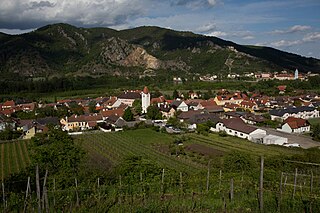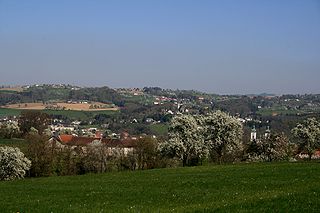Grafenegg is a market town (Municipality) in the Krems-Land district of Lower Austria, Austria.

Krems in Kärnten is a municipality in the district of Spittal an der Drau in Carinthia in Austria.

Furth bei Göttweig is a town and municipality in the district of Krems-Land in the Austrian state of Lower Austria. The municipality consists of the following populated places:

Rohrendorf bei Krems is a municipality in the district of Krems-Land in the Austrian state of Lower Austria.

Rossatz-Arnsdorf is a town in the district of Krems-Land in the Austrian state of Lower Austria. It is located in the Wachau valley of the Danube, a popular destination for tourists, and has excellent views of the ruins of castle Dürnstein, where King Richard the Lion-Heart of England was held captive by Duke Leopold V.

Senftenberg is a town in the district of Krems-Land in the Austrian state of Lower Austria.

Gießhübl is a town in the district of Mödling in the Austrian state of Lower Austria. It is located in the south of Vienna, the Austrian capital, neighboring the nature protection area Föhrenberge. With an altitude of 416 m, Gießhübl is the highest-located wine-growing district in Lower Austria. Originally Gießhübl was an agrarian village. Today it is mainly a residential area because of its vicinity to Vienna and the direct connection to the highway A21.
Leutasch is a municipality in the northern part of the district Innsbruck-Land in the Austrian state of Tyrol about 30 km northwest of Innsbruck and 10 km northwest of Seefeld in Tirol

Inzersdorf im Kremstal is a municipality in the district of Kirchdorf an der Krems in the Austrian state of Upper Austria.

Steinbach an der Steyr is a municipality in the district of Kirchdorf an der Krems in the Austrian state of Upper Austria.

Wartberg an der Krems is a municipality in the district of Kirchdorf an der Krems in the Austrian state of Upper Austria.

Kematen an der Krems is a municipality in the district Linz-Land in the Austrian state of Upper Austria.

Neuhofen an der Krems is a municipality in the district Linz-Land in the Austrian state of Upper Austria.

Sankt Johann am Wimberg is a municipality in the district of Rohrbach in the Austrian state of Upper Austria.
Aschach an der Steyr is a municipality in the district of Steyr-Land in the Austrian state of Upper Austria.

Rohr im Kremstal is a municipality in the district of Steyr-Land in the Austrian state of Upper Austria.

Sierning is a municipality in the district of Steyr-Land in the Austrian state of Upper Austria.

Sankt Ulrich bei Steyr is a municipality in the district of Steyr-Land in the Austrian state of Upper Austria.

Ternberg is a municipality in the district of Steyr-Land in the Austrian state of Upper Austria.

The geology of Surrey is dominated by sedimentary strata from the Cretaceous, overlaid by clay and superficial deposits from the Cenozoic.




















